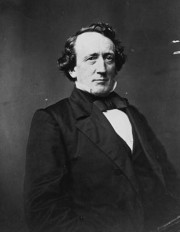1854 Ojibwe Land Cession Treaty
Signed Septmeber 30, 1854 at Lapointe, WI
In 1848, surveyors found a vein of copper on the north shore of Lake Superior. Michigan mining interests began pressuring the federal government to open the area for mining, which would involve a land cession from the Ojibwe.
The next year, Reuben B. Carlton arrived at Fond du Lac (now Duluth) to work as a blacksmith for the Ojibwe, in accordance with earlier treaty agreements. He became one of the original incorporators of the town of Fond du Lac (with D. G. Morrison and others), and took an interest in locating copper deposits.
The treaty by which the Ojibwe ceded the Arrowhead Region of Minnesota, opening the area for townsite development and mining, was signed in 1854. Five days before the treaty signing, Carlton formed a company in Ohio “for the purpose of obtaining mineral locations and lands in what is now the State of Minnesota.” Over the next several years, the company located several deposits, but the expected rush of miners never developed.
By the treaty of 1854, several reservations were created for Ojibwe people in Michigan, Wisconsin, a tract at the western tip of Lake Superior (near present-day Carlton, Minnesota), and the extreme northeastern corner of what is now Minnesota. The latter two reservations are today the home of the Fond du Lac and Grand Portage Bands of Lake Superior Chippewa. In addition, the Bois Fort band was entitled to select a reservation site, which was created near Lake Vermillion. (See Treaty of 1866.)
In this treaty, the Ojibwe retained extensive rights to use the land, including hunting and fishing rights. Today, resource management related to these treaty rights is undertaken in cooperation with the State of Minnesota.








